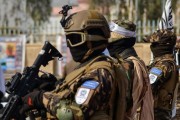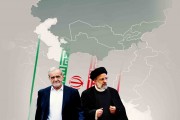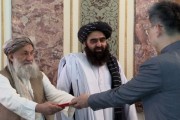Publish Date
Saturday 15 January 2022 - 10:21
recommended
0
New Afghanistan and its security links with surrounding area
Over the past four decades, Afghanistan initially was engaged in security dynamics with South Asia, and after the US invasion of the country in 2001, it established reciprocal security dynamics with the Middle East, Central Asia, and China. However, given the developments of the last twenty years, Afghanistan can practically be considered as a member of South Asia’s security complex. It seems that following the changes that have recently taken place in the country’s political system, Afghanistan is no more a securitizing issue for the surrounding countries. In this new environment, Afghanistan has almost no securitizing issue with the surrounding countries. Although the new environment is largely caused by the US withdrawal from Afghanistan, what is more important is the approach of the new Afghan government. What is obvious so far about the behavior of the new Afghan government is its willingness to pursue cooperative policies and create a non-security atmosphere, especially regarding the neighboring countries and peripheral powers. The implementation of such policies could lead Afghanistan out of war and conflict.
By: Abdulshakoor Salangi
According to the regional security complex theory, countries are located in security clusters. Security clusters refer to the existence of reciprocal security links that pit a number of countries against each other. Security ties also emerge when there are issues between a country and its neighbors or the neighbor of its neighbors, which require non-political means to be managed. The security ties arise from a variety of issues, such as border or territorial disputes, related populations, historical animosities, ideological or religious disputes, unification of one side with a great non-native power and so on.
These reciprocal security patterns, depending on their strength and weakness as well as the behavior of the parties, can put the regional countries in a situation that is interpreted in the theory of regional security complex as Securitization. For example, a variety of securitized issues between several countries in the Middle East region has created the Middle East’s regional security complex. What has been the situation of Afghanistan in the meantime? In other words, what kind of security issues have existed between Afghanistan and its neighbors? Which security complex includes Afghanistan? And more importantly, what has changed in the regional security situation of Afghanistan after the collapse of the Islamic Republic and the establishment of the Islamic Emirate?
Which security dynamics did connect Afghanistan to the surrounding areas?
If we put the incidents of the last forty years in order, especially those of the last two decades, we will see that Afghanistan was initially involved in security dynamics with South Asia, and after the US invasion of the country in 2001, Afghanistan received reciprocal security dynamics from other regions (Middle East, Central Asia, Russia, and China). The most important issues that connected Afghanistan to South Asia in terms of security and made the country prone to inclusion in the South Asia’s security complex were as follows: Border disputes between Afghanistan and Pakistan, the existence of related population between Afghanistan and Pakistan, the water disputes between Kabul and Islamabad, and most importantly, the friendly relations between Afghanistan and India and the two countries’ alliance against Pakistan.
Given these issues and their aggravation over the past twenty years, Afghanistan can be practically considered as a member of South Asia’s security complex. In fact, these wide range issues completely affected Afghanistan and Pakistan, and since India and Pakistan have also been grappling with security issues - such as the Kashmir dispute, water disputes and historical enmities (although the two countries have been separated for only seventy years, the polarization between them, one representing the Muslim community and the other representing the Hindu community, has created a kind of historical enmity between them)- , it led to the emergence of 2+1 formula (India and Afghanistan against Pakistan).
Such an equation, which was defined as a proxy war between Pakistan and India within Afghanistan’s territory, was so deadly that disrupted the lives of Afghans over the past twenty years. In this battle, the Indians tried to keep the flames of conflict between Afghanistan and Pakistan burning and promote anti-Pakistan sentiments, by indirectly influencing the political and security apparatus of Afghanistan. Pakistan, on the other hand, used a variety of tools to persuade Afghanistan to adjust its relations with India according to Pakistan's expectations. If India was not in the middle of Afghanistan-Pakistan relationship, then the issues between Afghanistan and Pakistan, even in a security situation, could not make the level of interaction between the two countries (Afghanistan and Pakistan) as secure and critical as it was during the past twenty years. In fact, Afghanistan had thrown itself into Pakistan’s well by twisting itself too much in India’s rope.
In terms of the security developments between Afghanistan and the Middle East, although Afghanistan is located in the neighborhood of Iran as one of the powers in the Middle East, there has been no security issue between the two countries so far. Although there were some attempts by specific circles in Afghanistan [possibly provoked by the external sources] to turn the issue of water (especially in the Helmand basin) into a securitize trouble in the relations between the two countries, the issue failed to securitize the existing interaction atmosphere. Although some issues that did not have the necessary impact - such as Iran's rivalry with the Persian Gulf states, especially Saudi Arabia – also existed in the past, the big issue that kept Iran involved in Afghanistan was the US presence in the country as Tehran’s number one enemy. Although the Iran-Afghanistan relations have been soft and somehow friendly over the past 20 years, Iran could not ignore the threats that came from the US presence in Afghanistan. Thus, Afghanistan, while not having security issues with Iran, was defined as a high-risk security space by Tehran, albeit due to an external factor.
Regarding Afghanistan's security ties with Central Asia, it can be said that the US presence in Afghanistan was the most important security factor. According to the theoretical views, the entry of a foreign great power into a region can completely change the security dynamics of that region and lead to some structural changes. Although at the beginning the US presence in Afghanistan was a positive event at least for Central Asia countries and could benefit them (for example, through renting the military bases to the US forces by Kyrgyzstan and Uzbekistan, or earn revenue through the northern transit route), this presence was not tolerable for Russia and China, as the regional and global rivals of the United States. The general perception in Russia and China about the US presence in Afghanistan was that the country intends to crawl into Central Asia (Heartland) through Afghanistan under the pretext of fighting terrorism. Moreover, the US acted as a major obstacle to the presence of these two countries in Afghanistan, by defining a hegemonic and exclusive role for itself in Afghanistan. Therefore, the two countries, while taking special bilateral and multilateral measures to keep Central Asia away from the US conspiracies, pursued different policies to drive the US out of Afghanistan.
Given the security dynamics and securitized issues, which security area includes Afghanistan?
Afghanistan is perhaps one of the rarest countries in the world that is part of its peripheral regions, and simultaneously is not a full member of them. Apart from the fact that this situation has given the country a special geopolitical identity, the theory of the security complex has also given it a very special situation. More specifically, Buzan's view (the regional security complex theorist) is that Afghanistan does not belong to any of its three neighboring security zones (Middle East, South Asia, and Central Asia). According to him, Afghanistan not only did not belong to any of these groups, but also had played the role of a buffer state (a region that is located within a regional security complex and separates the regional powers) until the early twentieth century, and from the middle of the twentieth century onwards, it has acted as an insulated state (an area separating the security dynamics of two or more security complexes).
While the view that Afghanistan was a buffer state until the first two decades of the twentieth century is somewhat plausible, the idea that the country was an insulated state in recent decades is not very consistent with the situation of Afghanistan and the country’s interaction with its surroundings. In fact, what can be concluded from Afghanistan's interactions with surrounding areas in recent decades is that the country has been involved in security issues so heavily that these issues securitized its interactions with the surrounding regions, took a leading role, and created security dynamics and security links. While Afghanistan was involved in the regional security dynamics, the establishment of the republic in 2004 also intensified the securitization of environment between Afghanistan and the neighboring countries which were located in three security complexes around it.
This situation manifested itself at two levels. At a higher level, it showed itself through the full-scale presence of a non-native power (actually the only existing superpower), and at a lower level, through a regional conflict between the warring sides that were present in Afghanistan. In this context, Afghanistan was simultaneously developing two security dynamics in itself: First, in partnership with an intolerable superpower for the surrounding region, it become a scene for indirect war between the United States and its rivals; and second, became a battleground between two regional powers based in South Asia, showing the country’s membership in one of its peripheral complexes. As a result, Afghanistan became more inclined towards South Asia’s security complex due to its membership in one of the three surrounding regions and the security issues related to it. Nevertheless, the US presence as a superpower in Afghanistan and a variety of the security issues it created, dragged Afghanistan’s foot into all the peripheral regions.
What has changed in Afghanistan’s regional security situation following the collapse of the Islamic Republic and the rise of the Islamic Emirate?
Following the US withdrawal and the collapse of the Islamic Republic of Afghanistan, many things have changed in the country. One of the most important changes is the profound transformation that has taken place in Afghanistan’s security atmosphere. This transformation that has caused by the change of political system, has brought about two major changes in the security environment of Afghanistan. First of all, the rivalry or, more profoundly, the proxy war between Pakistan and India has been ended completely in Islamabad's favor. It is obvious that the new government, called as the Islamic Emirate of Afghanistan, has put relations with Pakistan in priority and if it interacts with India, it will not be enough to arouse Pakistan's sensitivity.
Although the Indians are well aware that their 20-year investments in Afghanistan have all come to naught, they have sent some signals for normal relations with the new government of Afghanistan in line with their pragmatic policies. However, the fear that the new Afghan government would support Pakistan over Kashmir’s crisis will bother India. Meanwhile, since India has no stronger tools against the Islamic Emirate, any return to proxy war against Pakistan would also be impossible. In issues related to India and Pakistan, however, if the Afghan government unilaterally acts in Pakistan's favor, it will further contribute to Afghanistan's permanent membership in the South Asian security complex [which will not be a good event]. In that case, the only difference is that Afghanistan will no longer be the scene of conflict between the two countries. In the meantime, there is a weak possibility that could help India to return to Afghanistan’s scene: India’s support for the so-called Resistance Front (of course, if the Islamic Emirate does not come to terms with it). The extent of this return will depend on the actions of the Islamic Emirate against India in alignment and even alliance with Pakistan.
For the other actors in the Afghan scene who had security concerns about the US presence in Afghanistan, the US’ shaming withdrawal put an end on all the concerns in macro level. In fact, it can be said that after the US escape from Afghanistan, the security dynamics between Afghanistan and its peripheral powers, including Iran, Russia and China, came close to zero, because Kabul does not have any security issue with these countries at the local and bilateral level that could turn the interaction atmosphere into a security one. The only issue that still keeps these countries worried about Afghanistan is the presence of the terrorist groups such as The Islamic State Khorasan Province (ISKP), which in practice does not have enough strength and power to conduct any significant maneuver in Afghanistan against these countries. Moreover, the rise of ISKP may lead to more contacts and cooperation between the Islamic Emirate and the above-mentioned powers in terms of fight against the terrorist group.
In addition to these points, there are two other optimistic points about the reduction of security dynamics between Afghanistan and its peripheral environment. First, non-adoption of confrontational policies by the new Afghan government; and second, the Islamic Emirate’s decision to not allow any group to carry out destructive activities against another country through its territory. Even the day after the US evacuated the Kabul airport, the spokesman of the Islamic Emirate called on the United States to re-open its embassy in Kabul and pursue its legitimate interests in Afghanistan in accordance with the principles of international law.
Conclusion
After more than 40 years, Afghanistan is no more considered as a threat for the peripheral countries. In this new environment, Afghanistan has no securitizing issue with other countries. This situation is especially vital for the periphery of Afghanistan more than anywhere else. Although the new environment is largely caused by the US withdrawal from Afghanistan, what is more important is the kind of policies and approaches that the Afghan government adopts. What is commendable about the new government's behavior so far is the adoption of friendly and cooperative policies as well as creation of a non- security atmosphere with all countries, especially neighboring countries and peripheral powers. Continuation of such policies can keep Afghanistan away from war and distress. The other countries must also contribute to this process by treating the new government in a good manner and encouraging it to take the right internal and external paths.
According to the regional security complex theory, countries are located in security clusters. Security clusters refer to the existence of reciprocal security links that pit a number of countries against each other. Security ties also emerge when there are issues between a country and its neighbors or the neighbor of its neighbors, which require non-political means to be managed. The security ties arise from a variety of issues, such as border or territorial disputes, related populations, historical animosities, ideological or religious disputes, unification of one side with a great non-native power and so on.
These reciprocal security patterns, depending on their strength and weakness as well as the behavior of the parties, can put the regional countries in a situation that is interpreted in the theory of regional security complex as Securitization. For example, a variety of securitized issues between several countries in the Middle East region has created the Middle East’s regional security complex. What has been the situation of Afghanistan in the meantime? In other words, what kind of security issues have existed between Afghanistan and its neighbors? Which security complex includes Afghanistan? And more importantly, what has changed in the regional security situation of Afghanistan after the collapse of the Islamic Republic and the establishment of the Islamic Emirate?
Which security dynamics did connect Afghanistan to the surrounding areas?
If we put the incidents of the last forty years in order, especially those of the last two decades, we will see that Afghanistan was initially involved in security dynamics with South Asia, and after the US invasion of the country in 2001, Afghanistan received reciprocal security dynamics from other regions (Middle East, Central Asia, Russia, and China). The most important issues that connected Afghanistan to South Asia in terms of security and made the country prone to inclusion in the South Asia’s security complex were as follows: Border disputes between Afghanistan and Pakistan, the existence of related population between Afghanistan and Pakistan, the water disputes between Kabul and Islamabad, and most importantly, the friendly relations between Afghanistan and India and the two countries’ alliance against Pakistan.
Given these issues and their aggravation over the past twenty years, Afghanistan can be practically considered as a member of South Asia’s security complex. In fact, these wide range issues completely affected Afghanistan and Pakistan, and since India and Pakistan have also been grappling with security issues - such as the Kashmir dispute, water disputes and historical enmities (although the two countries have been separated for only seventy years, the polarization between them, one representing the Muslim community and the other representing the Hindu community, has created a kind of historical enmity between them)- , it led to the emergence of 2+1 formula (India and Afghanistan against Pakistan).
Such an equation, which was defined as a proxy war between Pakistan and India within Afghanistan’s territory, was so deadly that disrupted the lives of Afghans over the past twenty years. In this battle, the Indians tried to keep the flames of conflict between Afghanistan and Pakistan burning and promote anti-Pakistan sentiments, by indirectly influencing the political and security apparatus of Afghanistan. Pakistan, on the other hand, used a variety of tools to persuade Afghanistan to adjust its relations with India according to Pakistan's expectations. If India was not in the middle of Afghanistan-Pakistan relationship, then the issues between Afghanistan and Pakistan, even in a security situation, could not make the level of interaction between the two countries (Afghanistan and Pakistan) as secure and critical as it was during the past twenty years. In fact, Afghanistan had thrown itself into Pakistan’s well by twisting itself too much in India’s rope.
In terms of the security developments between Afghanistan and the Middle East, although Afghanistan is located in the neighborhood of Iran as one of the powers in the Middle East, there has been no security issue between the two countries so far. Although there were some attempts by specific circles in Afghanistan [possibly provoked by the external sources] to turn the issue of water (especially in the Helmand basin) into a securitize trouble in the relations between the two countries, the issue failed to securitize the existing interaction atmosphere. Although some issues that did not have the necessary impact - such as Iran's rivalry with the Persian Gulf states, especially Saudi Arabia – also existed in the past, the big issue that kept Iran involved in Afghanistan was the US presence in the country as Tehran’s number one enemy. Although the Iran-Afghanistan relations have been soft and somehow friendly over the past 20 years, Iran could not ignore the threats that came from the US presence in Afghanistan. Thus, Afghanistan, while not having security issues with Iran, was defined as a high-risk security space by Tehran, albeit due to an external factor.
Regarding Afghanistan's security ties with Central Asia, it can be said that the US presence in Afghanistan was the most important security factor. According to the theoretical views, the entry of a foreign great power into a region can completely change the security dynamics of that region and lead to some structural changes. Although at the beginning the US presence in Afghanistan was a positive event at least for Central Asia countries and could benefit them (for example, through renting the military bases to the US forces by Kyrgyzstan and Uzbekistan, or earn revenue through the northern transit route), this presence was not tolerable for Russia and China, as the regional and global rivals of the United States. The general perception in Russia and China about the US presence in Afghanistan was that the country intends to crawl into Central Asia (Heartland) through Afghanistan under the pretext of fighting terrorism. Moreover, the US acted as a major obstacle to the presence of these two countries in Afghanistan, by defining a hegemonic and exclusive role for itself in Afghanistan. Therefore, the two countries, while taking special bilateral and multilateral measures to keep Central Asia away from the US conspiracies, pursued different policies to drive the US out of Afghanistan.
Given the security dynamics and securitized issues, which security area includes Afghanistan?
Afghanistan is perhaps one of the rarest countries in the world that is part of its peripheral regions, and simultaneously is not a full member of them. Apart from the fact that this situation has given the country a special geopolitical identity, the theory of the security complex has also given it a very special situation. More specifically, Buzan's view (the regional security complex theorist) is that Afghanistan does not belong to any of its three neighboring security zones (Middle East, South Asia, and Central Asia). According to him, Afghanistan not only did not belong to any of these groups, but also had played the role of a buffer state (a region that is located within a regional security complex and separates the regional powers) until the early twentieth century, and from the middle of the twentieth century onwards, it has acted as an insulated state (an area separating the security dynamics of two or more security complexes).
While the view that Afghanistan was a buffer state until the first two decades of the twentieth century is somewhat plausible, the idea that the country was an insulated state in recent decades is not very consistent with the situation of Afghanistan and the country’s interaction with its surroundings. In fact, what can be concluded from Afghanistan's interactions with surrounding areas in recent decades is that the country has been involved in security issues so heavily that these issues securitized its interactions with the surrounding regions, took a leading role, and created security dynamics and security links. While Afghanistan was involved in the regional security dynamics, the establishment of the republic in 2004 also intensified the securitization of environment between Afghanistan and the neighboring countries which were located in three security complexes around it.
This situation manifested itself at two levels. At a higher level, it showed itself through the full-scale presence of a non-native power (actually the only existing superpower), and at a lower level, through a regional conflict between the warring sides that were present in Afghanistan. In this context, Afghanistan was simultaneously developing two security dynamics in itself: First, in partnership with an intolerable superpower for the surrounding region, it become a scene for indirect war between the United States and its rivals; and second, became a battleground between two regional powers based in South Asia, showing the country’s membership in one of its peripheral complexes. As a result, Afghanistan became more inclined towards South Asia’s security complex due to its membership in one of the three surrounding regions and the security issues related to it. Nevertheless, the US presence as a superpower in Afghanistan and a variety of the security issues it created, dragged Afghanistan’s foot into all the peripheral regions.
What has changed in Afghanistan’s regional security situation following the collapse of the Islamic Republic and the rise of the Islamic Emirate?
Following the US withdrawal and the collapse of the Islamic Republic of Afghanistan, many things have changed in the country. One of the most important changes is the profound transformation that has taken place in Afghanistan’s security atmosphere. This transformation that has caused by the change of political system, has brought about two major changes in the security environment of Afghanistan. First of all, the rivalry or, more profoundly, the proxy war between Pakistan and India has been ended completely in Islamabad's favor. It is obvious that the new government, called as the Islamic Emirate of Afghanistan, has put relations with Pakistan in priority and if it interacts with India, it will not be enough to arouse Pakistan's sensitivity.
Although the Indians are well aware that their 20-year investments in Afghanistan have all come to naught, they have sent some signals for normal relations with the new government of Afghanistan in line with their pragmatic policies. However, the fear that the new Afghan government would support Pakistan over Kashmir’s crisis will bother India. Meanwhile, since India has no stronger tools against the Islamic Emirate, any return to proxy war against Pakistan would also be impossible. In issues related to India and Pakistan, however, if the Afghan government unilaterally acts in Pakistan's favor, it will further contribute to Afghanistan's permanent membership in the South Asian security complex [which will not be a good event]. In that case, the only difference is that Afghanistan will no longer be the scene of conflict between the two countries. In the meantime, there is a weak possibility that could help India to return to Afghanistan’s scene: India’s support for the so-called Resistance Front (of course, if the Islamic Emirate does not come to terms with it). The extent of this return will depend on the actions of the Islamic Emirate against India in alignment and even alliance with Pakistan.
For the other actors in the Afghan scene who had security concerns about the US presence in Afghanistan, the US’ shaming withdrawal put an end on all the concerns in macro level. In fact, it can be said that after the US escape from Afghanistan, the security dynamics between Afghanistan and its peripheral powers, including Iran, Russia and China, came close to zero, because Kabul does not have any security issue with these countries at the local and bilateral level that could turn the interaction atmosphere into a security one. The only issue that still keeps these countries worried about Afghanistan is the presence of the terrorist groups such as The Islamic State Khorasan Province (ISKP), which in practice does not have enough strength and power to conduct any significant maneuver in Afghanistan against these countries. Moreover, the rise of ISKP may lead to more contacts and cooperation between the Islamic Emirate and the above-mentioned powers in terms of fight against the terrorist group.
In addition to these points, there are two other optimistic points about the reduction of security dynamics between Afghanistan and its peripheral environment. First, non-adoption of confrontational policies by the new Afghan government; and second, the Islamic Emirate’s decision to not allow any group to carry out destructive activities against another country through its territory. Even the day after the US evacuated the Kabul airport, the spokesman of the Islamic Emirate called on the United States to re-open its embassy in Kabul and pursue its legitimate interests in Afghanistan in accordance with the principles of international law.
Conclusion
After more than 40 years, Afghanistan is no more considered as a threat for the peripheral countries. In this new environment, Afghanistan has no securitizing issue with other countries. This situation is especially vital for the periphery of Afghanistan more than anywhere else. Although the new environment is largely caused by the US withdrawal from Afghanistan, what is more important is the kind of policies and approaches that the Afghan government adopts. What is commendable about the new government's behavior so far is the adoption of friendly and cooperative policies as well as creation of a non- security atmosphere with all countries, especially neighboring countries and peripheral powers. Continuation of such policies can keep Afghanistan away from war and distress. The other countries must also contribute to this process by treating the new government in a good manner and encouraging it to take the right internal and external paths.
Abdulshakoor Salangi, is an Afghan researcher based in Kabul
News code:2947


















